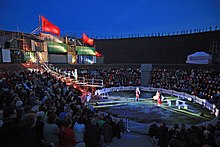Haniel dump
The Haniel dump in Bottrop (on the border with Oberhausen-Königshardt) is 159 m high (184.9 m above sea level ) one of the highest dumps in the Ruhr area . It was piled up in the form of two spirals through overburden from the Prosper-Haniel coal mine . The Schöttelheide dump joins in the north .
Cultivation and Use
On the plateau of the southern spiral, the summit cross was erected in 1992, which was made on the occasion of the visit of Pope John Paul II on May 2, 1987 by trainees of the mine from laths and blessed by Bishop Franz Hengsbach on Good Friday of the same year. It is part of a Way of the Cross with 15 stations that begins at Kleekamp , and for a while also marked the Haldenspitze as a landmark . The plateau is no longer the highest point today due to further debris north of the cross. The Way of the Cross, designed by Tisa von der Schulenburg and Adolf Radecki , was inaugurated in 1995 by Bishop Hubert Luthe . Here find good friday regular processions take place. The Way of the Cross is combined with an educational mining trail with typical mining machines and equipment. Next to the wooden cross - at a height of 126 meters - there is a full circle amphitheater with 800 seats, the mountain arena . Cultural and theater events take place here regularly, including the plays Jedermann (1999), A Midsummer Night's Dream (2001), The Threepenny Opera (2002) and Cabaret (2003). On the occasion of the “ Ruhr.2010 ” Capital of Culture year , a new production of Giuseppe Verdi's opera Aida took place here under the artistic direction of the Bottrop-based director Thomas Grandoch .
In 2016, the Bergarena on Halde Haniel became the scene of a major opera production by the city of Bottrop for the second time: Thomas Grandoch staged the opera Der fiegen Holländer by Richard Wagner with over 300 participants on and behind the stage.
In 2002, the installation Totems by the Basque painter and sculptor Agustín Ibarrola was created from over one hundred railway sleepers. The work combines the "apparent opposites of industrial space and nature" (statement by the artist). In 2007 the installation, also known as the wind comb , was refurbished and implemented. Today the thresholds stand on the edge of a crescent-shaped hill, which also represents the highest point of the dump and the wind protection for the mountain arena.
The dump is a panorama of the Route of Industrial Culture and offers a view of the nearby mine and the northwestern Ruhr area.
Flora and fauna
Due to the closure and renaturation of the dump, many animal and plant species were able to settle in the fallow area. At the foot of the heap there is a dense deciduous forest , which is also typical in the surrounding region. In addition to blackberries and various ferns, there are also areas with wild roses , which mix with conifers as the height increases . The highest levels of the heap are covered with grass and isolated pioneer plants such as camomiles .
In addition to the flora, a remarkable fauna community has formed. In addition to different hymenoptera , these include kestrels , common toads , sand lizards and wild rabbits . Some of the animal species found there are now endangered in their populations in North Rhine-Westphalia .
Fossils
The overburden from hard coal mining dumped on the Haniel dump comes from the layers of carbon and therefore partly contains fossil prints of plants from that era.
gallery
See also
literature
- Wolfgang Berke : Over all mountains. The definitive stockpile guide in the Ruhr area. Klartext Verlag, Essen 2009, ISBN 978-3-8375-0170-4 , p. 134ff.
Individual evidence
- ↑ The West: No Second Class Production. Retrieved October 21, 2011 .
Web links
- Description of this sight and panorama point on the route of industrial culture
- Halde Haniel at www.ruhrgebiet-industriekultur.de
- RAG: Mining in Bottrop - From foundation to cessation of subsidies (PDF)
Coordinates: 51 ° 33 ′ 1.5 ″ N , 6 ° 52 ′ 32.8 ″ E












